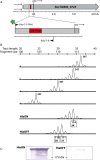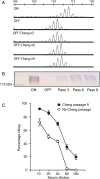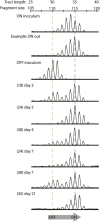Selection and Counterselection of Hia Expression Reveals a Key Role for Phase-Variable Expression of Hia in Infection Caused by Nontypeable Haemophilus influenzae
- PMID: 25712964
- PMCID: PMC4539897
- DOI: 10.1093/infdis/jiv103
Selection and Counterselection of Hia Expression Reveals a Key Role for Phase-Variable Expression of Hia in Infection Caused by Nontypeable Haemophilus influenzae
Abstract
Hia is a major adhesin of nontypeable Haemophilus influenzae (NTHi) and has long been investigated as a vaccine candidate. Here we show that Hia phase variation is controlled by changes in the length of a polythymidine tract located in the hia promoter. Studies of an invasive clinical isolate (strain R2866) show that strains expressing high Hia levels are more efficiently killed by opsonophagocytosis. An opsonophagocytic assay was used to select for a subpopulation of variants that expressed a low level of Hia, which facilitated their escape from killing by anti-Hia antisera. Conversely, a subpopulation of variants expressing a high level of Hia was selected for during passaging through Chang cells. In both cases, phase variation of Hia expression corresponded directly with discrete modal changes in polythymidine tract length. In the chinchilla model of NTHi infection, we observed consistent selection for high Hia expression upon nasopharyngeal colonization, confirming the key role of phase-variable expression of Hia within a specific niche in vivo.
Keywords: Haemophilus; adhesion; colonization; phase variation.
© The Author 2015. Published by Oxford University Press on behalf of the Infectious Diseases Society of America. All rights reserved. For Permissions, please e-mail: journals.permissions@oup.com.
Figures




Similar articles
-
Immunogenicity of Nontypeable Haemophilus influenzae Outer Membrane Vesicles and Protective Ability in the Chinchilla Model of Otitis Media.Clin Vaccine Immunol. 2017 Oct 5;24(10):e00138-17. doi: 10.1128/CVI.00138-17. Print 2017 Oct. Clin Vaccine Immunol. 2017. PMID: 28768669 Free PMC article.
-
Antibodies to the HMW1/HMW2 and Hia adhesins of nontypeable haemophilus influenzae mediate broad-based opsonophagocytic killing of homologous and heterologous strains.Clin Vaccine Immunol. 2014 May;21(5):613-21. doi: 10.1128/CVI.00772-13. Epub 2014 Feb 26. Clin Vaccine Immunol. 2014. PMID: 24574538 Free PMC article.
-
The Nontypeable Haemophilus influenzae Major Adhesin Hia Is a Dual-Function Lectin That Binds to Human-Specific Respiratory Tract Sialic Acid Glycan Receptors.mBio. 2020 Nov 3;11(6):e02714-20. doi: 10.1128/mBio.02714-20. mBio. 2020. PMID: 33144377 Free PMC article.
-
Nontypeable Haemophilus influenzae as a pathogen in children.Pediatr Infect Dis J. 2009 Jan;28(1):43-8. doi: 10.1097/INF.0b013e318184dba2. Pediatr Infect Dis J. 2009. PMID: 19057458 Review.
-
Developing a nontypeable Haemophilus influenzae (NTHi) vaccine.Vaccine. 2000 Dec 8;19 Suppl 1:S108-15. doi: 10.1016/s0264-410x(00)00288-7. Vaccine. 2000. PMID: 11163473 Review.
Cited by
-
Non-Typeable Haemophilus influenzae Invade Choroid Plexus Epithelial Cells in a Polar Fashion.Int J Mol Sci. 2020 Aug 10;21(16):5739. doi: 10.3390/ijms21165739. Int J Mol Sci. 2020. PMID: 32785145 Free PMC article.
-
Gene Expression Regulation in Airway Pathogens: Importance for Otitis Media.Front Cell Infect Microbiol. 2022 Feb 11;12:826018. doi: 10.3389/fcimb.2022.826018. eCollection 2022. Front Cell Infect Microbiol. 2022. PMID: 35252035 Free PMC article. Review.
-
DNA sequence repeats identify numerous Type I restriction-modification systems that are potential epigenetic regulators controlling phase-variable regulons; phasevarions.FASEB J. 2020 Jan;34(1):1038-1051. doi: 10.1096/fj.201901536RR. Epub 2019 Nov 28. FASEB J. 2020. PMID: 31914596 Free PMC article.
-
Naturally Acquired HMW1- and HMW2-Specific Serum Antibodies in Adults and Children Mediate Opsonophagocytic Killing of Nontypeable Haemophilus influenzae.Clin Vaccine Immunol. 2015 Oct 28;23(1):37-46. doi: 10.1128/CVI.00502-15. Print 2016 Jan. Clin Vaccine Immunol. 2015. PMID: 26512048 Free PMC article.
-
Why we need a vaccine for non-typeable Haemophilus influenzae.Hum Vaccin Immunother. 2016 Sep;12(9):2357-61. doi: 10.1080/21645515.2016.1174354. Epub 2016 May 12. Hum Vaccin Immunother. 2016. PMID: 27171854 Free PMC article.
References
-
- Haggard M. Otitis media: prospects for prevention. Vaccine 2008; 26(suppl 7):G20–4. - PubMed
-
- Johnson RH. Community-acquired pneumonia: etiology, diagnosis, and treatment. Clin Ther 1988; 10:568–73. - PubMed
-
- Sethi S, Murphy TF. Infection in the pathogenesis and course of chronic obstructive pulmonary disease. N Engl J Med 2008; 359:2355–65. - PubMed
-
- A.A.P. Diagnosis and management of acute otitis media. Pediatrics 2004; 113:1451–65. - PubMed
-
- Alsarraf R, Jung CJ, Perkins J, Crowley C, Alsarraf NW, Gates GA. Measuring the indirect and direct costs of acute otitis media. Arch Otolaryngol Head Neck Surg 1999; 125:12–8. - PubMed
Publication types
MeSH terms
Substances
Grants and funding
LinkOut - more resources
Full Text Sources
Other Literature Sources
Medical

